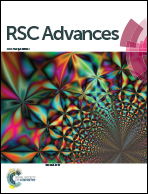Enhanced dielectric properties of acrylic resin elastomer based nanocomposite with thermally reduced graphene nanosheets†
Abstract
Acrylic resin elastomer (ARE) has drawn considerable attention in recent years due to its excellent film-forming properties, flexibility and elasticity. However, its low dielectric constant restricts its application. In this work, an ARE based composite material with enhanced dielectric properties was obtained via adding graphene nanosheets prepared by thermal reduction (TrGN) to the ARE (ARE/TrGN). Furthermore, polyvinylpyrrolidone (PVP) has been used to improve the dispersibility of TrGN in the ARE matrix (the resulting composites are hereby referred to as ARE/PVP-TrGN). It was found that the addition of PVP to the ARE composite material could increase the percolation threshold and dielectric constant of the composite. The results demonstrated that ARE/PVP-TrGN had a percolation threshold of 1.65 wt%, and when the loading of the filler was 1.6 wt%, at 100 Hz, it had a dielectric constant higher than 100, representing a 30 fold increase with respect to the neat ARE, and a low dielectric loss of 0.2. In addition, the thermogravimetric (TG) analysis indicated that the composite possessed better thermal stability than that of neat ARE. The elastic modulus of ARE/2% PVP-TrGN was lower than 6 MPa.


 Please wait while we load your content...
Please wait while we load your content...